Presidents: Abraham Lincoln
Abraham Lincoln Birthplace National Historical Park, Kentucky
Visited in 2007 and 2013.
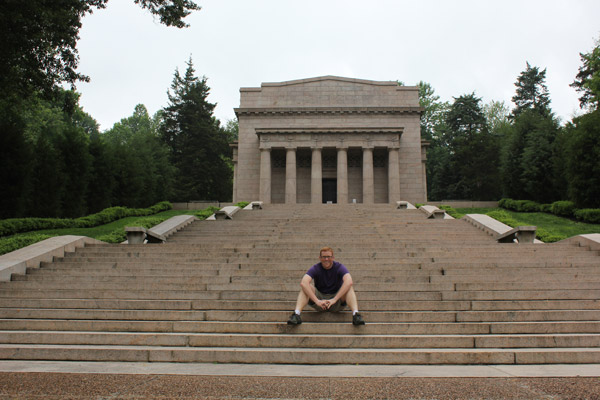
The original Lincoln Memorial.
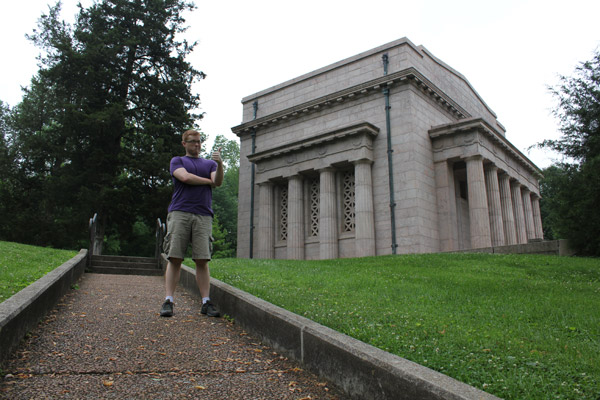
A building built to house a log cabin with no historical significance.
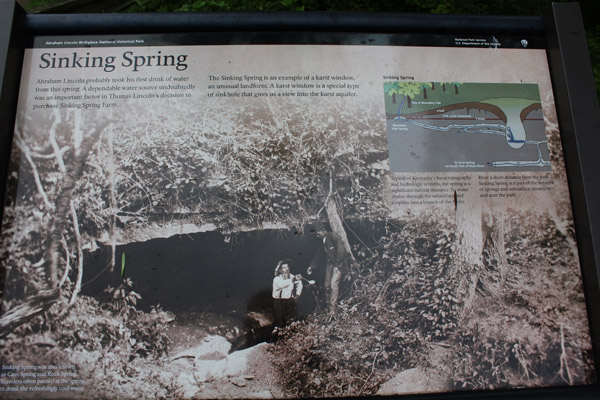
Signage for the Sinking Spring.
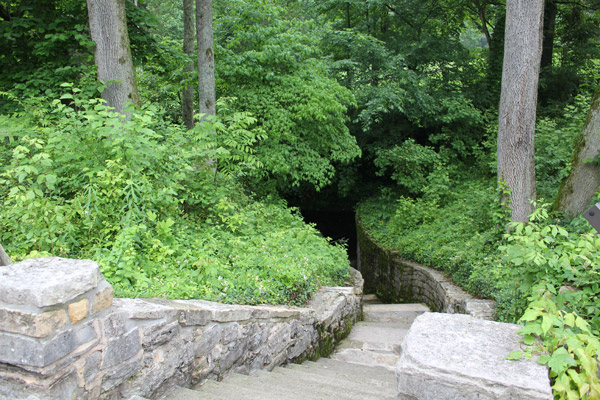
The entrance to the Sinking Spring today (circa 2013).
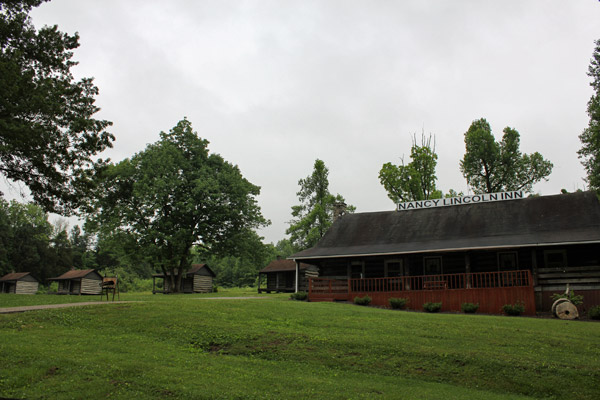
What we used to call Americana.
In the spring of 2007, I went on one of the longest comedy trips of my not-that-distinguished career; it involved a 3,000-mile figure eight that went as far north as the Upper Peninsula of Michigan and as far south as Georgia. I was in the home stretch as I plowed into Kentucky. I found a hotel near Elizabethtown, and when I woke up there, it was with the knowledge that I had to be in Atlanta -- 360 miles away -- for a show that evening. If I recall correctly, it was some kind of a showcase for a Comedy Central competition, one of the people on the show was Theo Vonn (formerly of the Real World, who was not at that time all that good at comedy), and the audience really did not like me (and loved Theo Vonn). The day after that, I had to drive 600 miles home. The thing about showbusiness is this: Sometimes you have to drive 1,000 miles to perform an unpaid six-minute set, for the extremely small chance that some 21-year-old tastemaking intern / talent scout might find you amusing. Because showbusiness is UNBELIEVABLY STUPID. Keep chasing that rainbow, kids.
Maybe my problem, aside from a general lack of talent, was that I wasn't focused enough on the comedy. I stopped in Elizabethtown for a reason. I wanted to see some Lincoln logs.
Abe Lincoln is happily claimed by the tourism board of every municipality where he ate, sneezed or spit. Hodgenville has a better claim than most, because Lincoln was born there. Thomas Lincoln was looking to move up in the world, and in the early 19th century that meant moving West, he bought a 300-acre farm with spring and started cultivating what was then some godforsaken wilderness. A few years later, he had to relocate, as a title dispute over the land put the whole operation in legal limbo. But the history was already made. In 1809, in a cabin not far from the Sinking Spring, his wife Nancy popped out a son. Within seconds of his birth, young Abe had chopped down a cherry tree, wrestled a bear into submission and laid 50 miles of railroad track. Also, a chorus of angels began singing "You Can't Always Get What You Want," while every slave in the South began spontaneously weeping.
In truth, there's not all that much to see at the Lincoln Birthplace, but I did want to see it again. Since 2007, I had visited far more sites from Lincoln's life and read so much more about the guy. I thought it would be more meaningful this time, since I'm reaching the age where I get to take myself seriously all the time, and the folks around me have just learned to deal with it. It wasn't really any different, but I was happy to return. It's like seeing an old friend.
You have to drive though the countryside a few miles to get to the site; just like in 2007, I was the first person on site who wasn't a park ranger or volunteer. It's nicer that way, because without other visitors ruining the illusion, the Lincoln Birthplace is a Greek temple set in the woods -- something out of a classical landscape painting hanging in a museum. Wear a toga when you go. You'll feel more special that way.
There was a time when people truly believed that the log cabin on site was Lincoln's actual birth cabin (or at least had logs from the original). To protect and sanctify the structure, they built a temple large enough to house the cabin. It's on top of a hill, and the staircase to the top has one step for each year of Lincoln's life. The inside doesn't have any ornamentation other than the cabin, and the cabin is as plain as can be. You can actually see numbers on some of the logs, which people used as an assembly guide whenever they tore it down and rebuilt it -- back when seeing a historic log cabin at a state fair was a big deal. There aren't really many questions to ask.
At the foot of the stairs, you can see the entrance to the spring. A few hundred feet to the side, there's the remains of an old "roadside America" attraction -- back in the day, you could spend the night in a small log cabin rented from the Nancy Lincoln Inn, so that you could experience all the joys of being born in a log cabin for yourself. And of course, there's a visitor's center, where you can read about frontier living and see the Lincoln family bible.
From a dispassionate perspective, there's no real reason for the temple, or the cabin, or the visitors center. Lots of presidential birthplaces are marked with road signs, and there's nothing left at Sinking Spring that merits much more than a sign. The only reason we care is because it's Lincoln, whom history has judged to be the greatest president to date.
And I think that's enough. There's something manufactured about it all, but it has its purpose. The nation as it was conceived in 1787 was flawed. It still had its problems in 1865, but Lincoln was the guy who oversaw the rebirth, when we started over without our original sin. There's romantic about it, so it doesn't seem entirely ridiculous to glorify his journey. The original birth of the nation was wrapped in war and politics and semantics, so it's hard to wrap your head around it all; the rebirth starts in a log cabin in the wilderness, which is a bit more legendary.
Sometimes it's OK to want the legend.
If you're in the area to check out the birthplace, you might as well go down the road a few miles and check out Lincoln's Kentucky "boyhood home." There's nothing left there but nature trails and open fields, but in nice weather it's a pleasant place for a stroll.
Lincoln Boyhood National Memorial, Indiana
Visited in 2011.
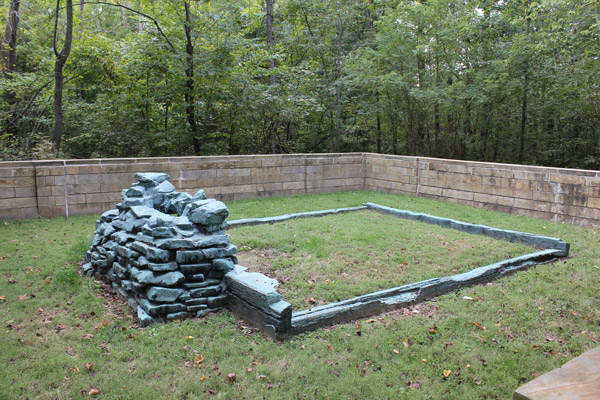
Great men have strong foundations.
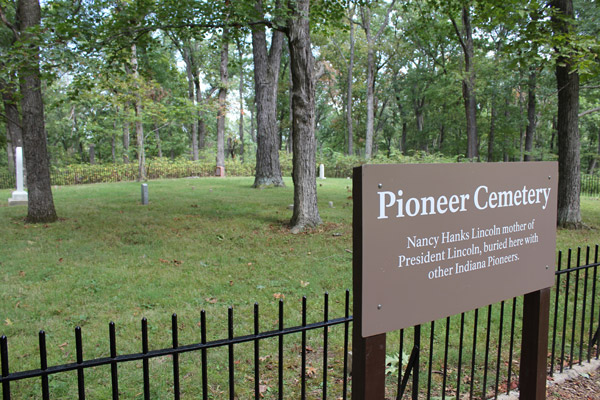
Nancy's final resting place.
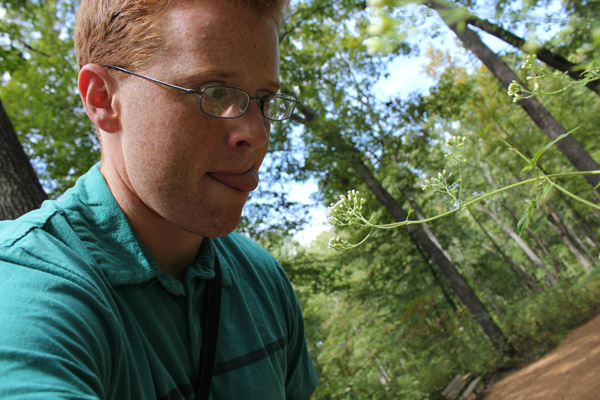
No one can resist sweet, delicious snake root.
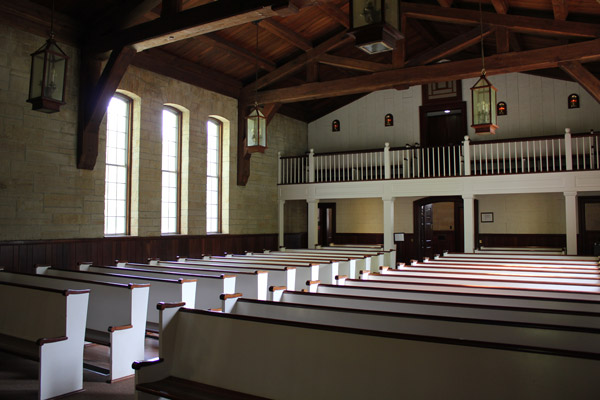
A nice memorial chapel where you can pray about Lincoln and stuff.
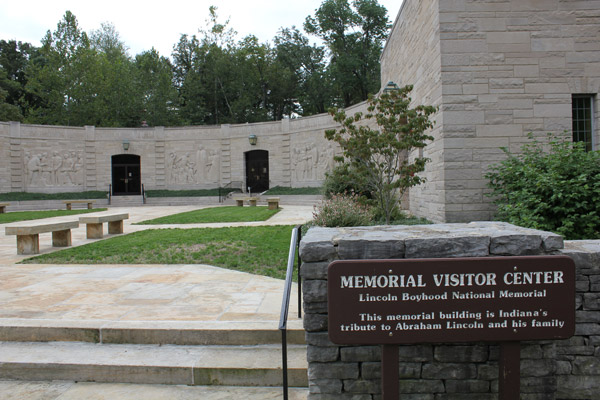
The visitors center for the monument.
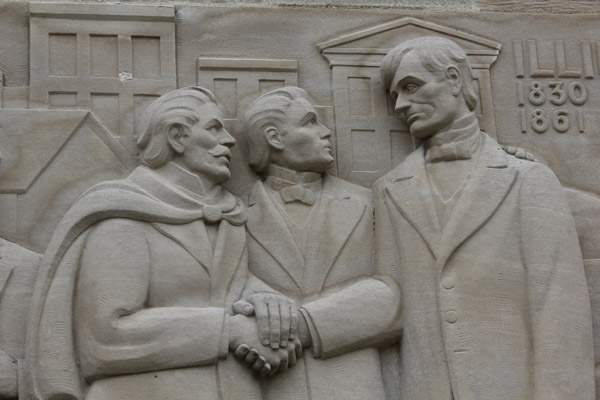
The famous meeting between Lincoln and Uncle Joe.
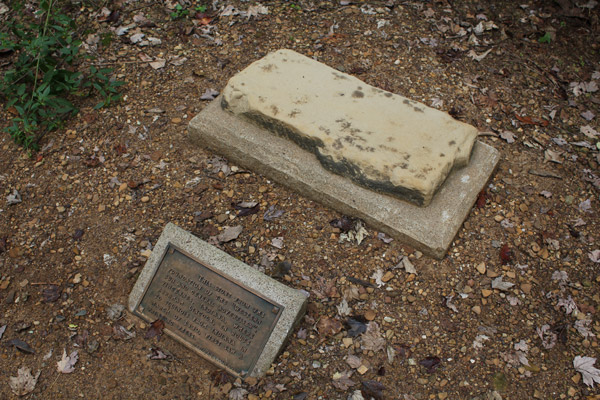
Behold the wonders of the TRAIL OF TWELVE STONES!
Milk, so essential to the development of strong bones and health teeth, also developed the free world. By killing Nancy Hanks Lincoln.
Sort of. What actually got her was snake root. Cows tended to eat it, which poisoned their milk. Modern medicine has made "milk sickness" a thing of the past, but in 1818 it was wiping out the milk-loving, god-fearing people of Southern Indiana. It killed Nancy, and the state of Indiana and the National Park Service now team up to honor her memory -- with a few acres of snake root.
Yummy! All this and more can be enjoyed at the Lincoln Boyhood National Monument, in scenic Lincoln City. It's a subdued site, but arguably an important one; the Lincolns moved there when Abe was 7, and he lived there until he was 21. His frontier upbringing started in Kentucky, but it blossomed in Indiana.
His mom's death shaped Abe's personality and thrust new responsibilities on his gawky shoulders. His stepmom entered the picture, his informal education continued, and he learned the value of hard work while toiling beside his father on a farm chopped out of the wilderness. Had Nancy Hanks been a lactard, the South might have won the war.
That's why Nancy's grave is probably the main historical attraction of the site. Leaving the visitor's center, two colonnades of trees line a wide path cut in a hillside. An illuminated flag pole sits at the top, and hidden in the trees just beyond that is the pioneer cemetery where Nancy is resting with the other people who got milk.
Walking farther, there's another path through the snake-root-infested woods. The trees are thick enough to give you that 1815 sense of isolation and wilderness, and there was a historical smell in the air: either snake root is disturbingly pungent, or I was downwind from a sewer backup.
When the trail ends, you're confronted with what's left of Thomas Lincoln's 300-acre farm. It's a hole in the ground. The cabin, built by Abe and Thomas together, is long gone. They did find some evidence of the foundation and hearth, however, so a bronze cast was put in place to mark the site. There's also a "living history" farm operated under 1820s standards, but those things always suck, so I headed instead to the awesomely titled "Trail of Twelve Stones."
Sadly, it's false advertising. There were no riddles, feats of strength, booby traps or hidden speakers playing Iron Maiden hits. The trail just winds past 12 small rocks taken from various buildings important to Lincoln's life. But it does dump you back at the far more interesting stones on the visitors center. There are four friezes on the outside of the building, and each panel has an allegorical image representing a phase of Lincoln's life. My favorite one is about the time that Lincoln met Josef Stalin.
Lincoln's New Salem State Historic Site, Illinois
Visited in 2011.
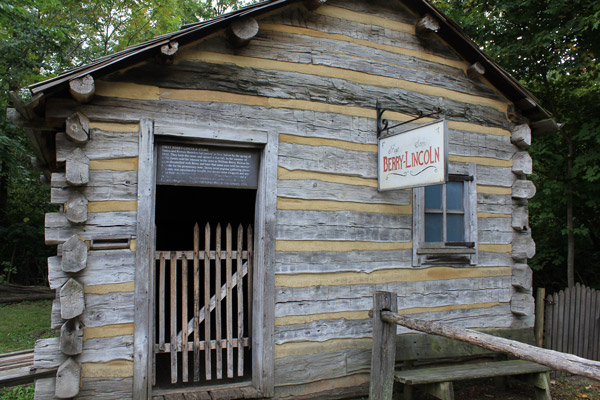
New Salem: Lincoln be shoppin'.
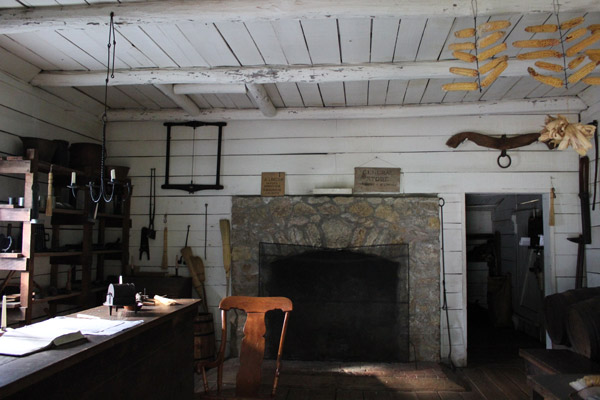
New Salem: What's in store.
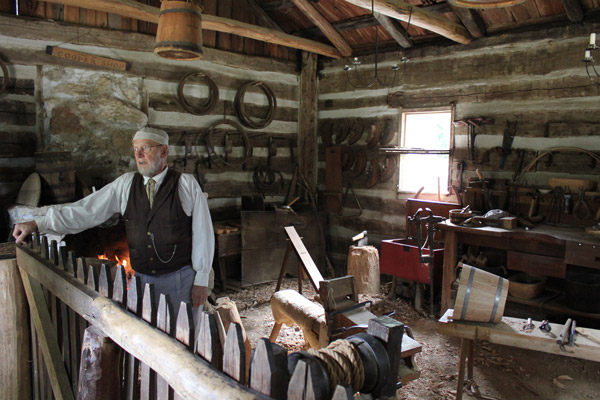
Hangin' with Mr. Cooper.
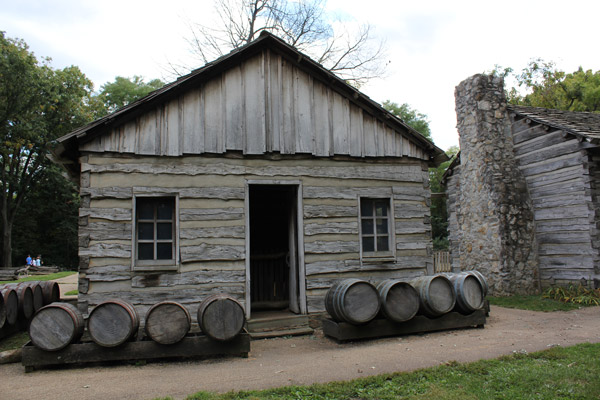
Hangin' with Mr. Cooper.
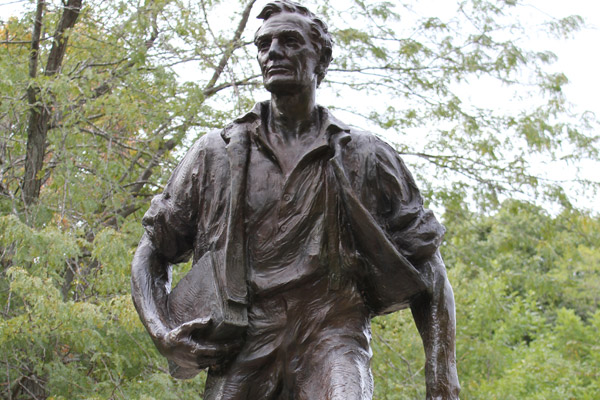
The iconic Lincoln image, courtesy of New Salem.
There's historic Abraham Lincoln, and then there's legendary Lincoln: the one who split a rail made from a cherry tree, threw a $50 bill across the Sangamon River and wrestled a bear to become the king of Illinois. A lot of the legend comes from New Salem.
Let's start you off with some back story: Lincoln and his dad didn't get along. Lincoln's young adulthood in Indiana wasn't all that fun. There was lots drudgery as the family tried to hack a living out of the middle of a dense forest. Sometimes Thomas would pimp his son out as a laborer and keep most of the money. The only real relief from the drudgery was reading, and the occasional arts and crafts project, like making his mother's coffin.
The family moved to Illinois when Lincoln was 21, but Abe had enough. He set out on his own and never saw his dad again. One of his first jobs was for a man named Denton Offutt, who hired Abe to take a flatboat loaded with cargo to New Orleans. Floating down the Sangamon River, the flatboat got stuck on the dam for a sawmill. During the unexpected stop, Offutt was impressed enough by the newly founded nearby town that he decided to open a shop there. He was impressed enough by Lincoln to bring him on as shopkeeper.
For the next six years, Lincoln was the lovable, goofy handyman in the sitcom that was New Salem. He had a lot of jobs, since the original store ended up being a bust. Lincoln worked as a rail splitter, shop owner, children's birthday party clown and farm worker. He also snagged part-time government work as the postmaster and, interestingly enough, the local surveyor -- the same job that got George Washington off the ground. He had his brief stint with military service in New Salem, as a militia captain in the Black Hawk War (no hostile Indians encountered). And he was popular enough to get elected to the state Assembly.
But mostly, he read. To become a lawyer in the 1830s, you didn't have to borrow $100,000, then live with your parents for three years while searching for a $35,000 job that requires 60-hour work weeks. All you had to do was study really hard and take a test. That's how Lincoln spent his spare time, and after a few years of folksy suburban toiling, he was ready to move to the big city of Springfield as a full-fledged lawyer.
Unfortunately, Lincoln was the linchpin of the New Salem economy, and a few years after his departure the town disappeared. (Also, they found out that steamboats couldn't navigate the Sangamon, so that didn't help.) What you're visiting today is courtesy of William Randolph Hearst -- Citizen Kane -- who snagged the property early in the 20th century. In the 1930s the CCC started building some replica structures, and over time it has developed into a 23-building "living history" village. I got there late in the day, so only the cooper was on duty. But there's nothing more exciting than buckets.
FUN NEW SALEM FACTS!
- Lincoln is the only president to hold a patent, and it is for a method to get a stuck boat over a sandbar. Historians believe this is tied directly to his desire never to get stuck in a craphole like New Salem again.
- New Salem was the site of Lincoln's famous "wrestling match," when someone bet the newcomer he couldn't take down one of the town ruffians. Depending on the eyewitness, Lincoln either won, lost cleanly, or lost when the other guy cheated. Everyone agrees, however, that Lincoln won the respect of all the drunken losers in town.
- Lincoln had no "home" in New Salem, instead sleeping in his shops, renting rooms from townspeople or crashing in a lean-to known as "Abe's Love Emporium."
- Lincoln allegedly had at least one romance while in New Salem, with Ann Rutledge. It's possible the stories were trumped up, however, to justify five chapters of sex scenes in early versions of Lincoln biographies.
Lincoln Home National Historic Site, Springfield, Illinois
Visited in 2011.
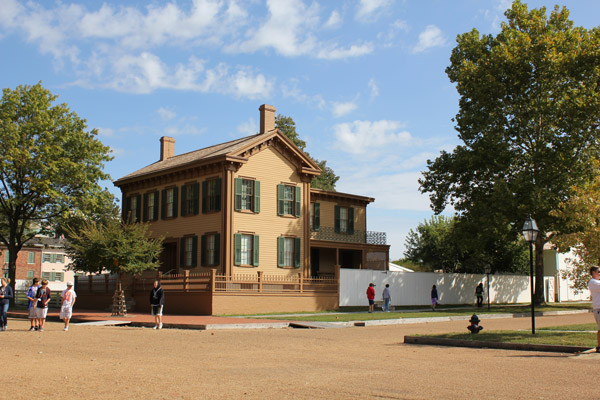
Upper-middle-class living at its finest.
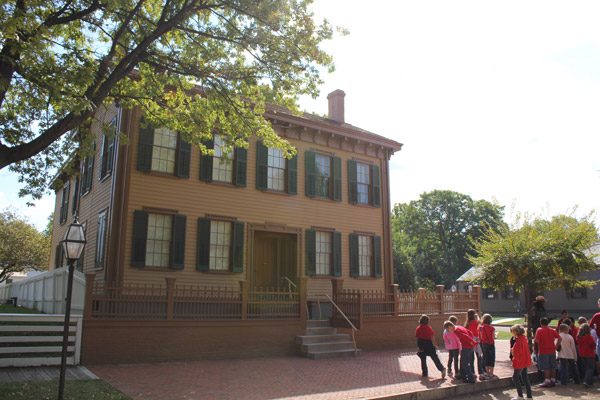
The National Park Service keeps this place in nice shape.
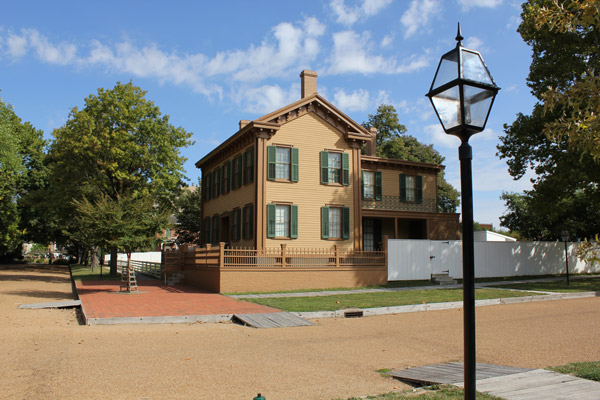
The lampost was imported from Narnia.
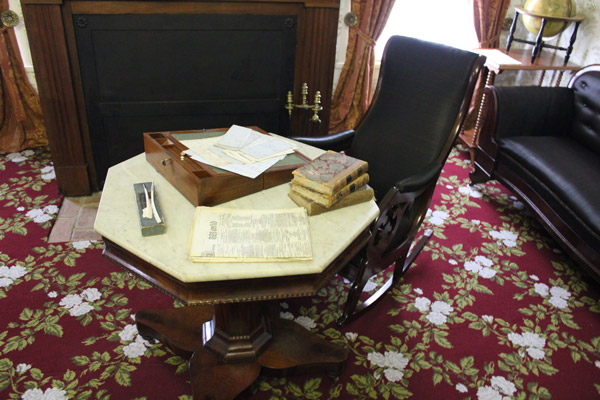
The back parlor, I think.
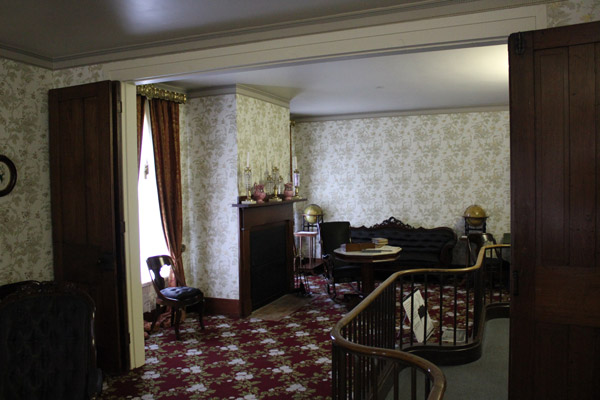
Where people would party with Abe and Mary.
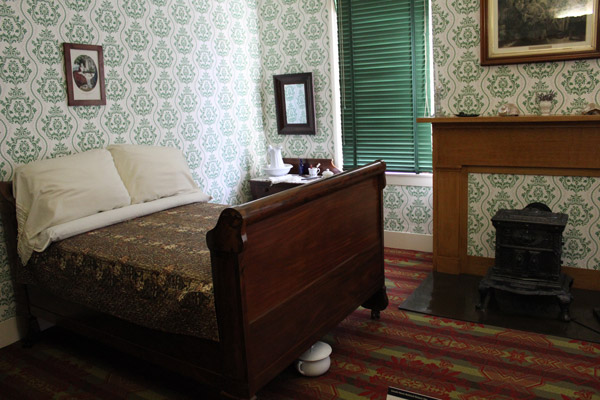
A less famous Lincoln Bedroom.
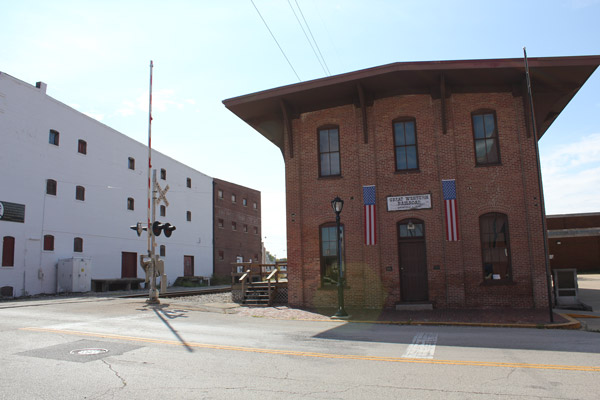
The Lincoln Depot: Say hello to Lincoln's goodbye to Springfield.
The problem with Abe Lincoln is knowing where to begin. In life, he held together the Union; in death, he holds together the Illinois tourist economy. Some time ago, the state council of elders -- Richard Daley's poker buddies -- came up with the "Land of Lincoln" motto, and being Chicago poker players, they went all in. (You can do that when you cheat at poker.) Every object or surface Lincoln touched, fondled, stood upon or sneezed near is graced with a historical marker, or (if he sneezed twice) a state park.
Same goes with the literature: One sign I saw claimed that Lincoln is second only to Jesus is number of books written about his life. But with Jesus, you can always go with the best-seller and feel pretty good about your choice. In the case of Lincoln, you have to decide if you want his life interpreted through a lens of depression, a loving marriage, a hateful marriage, homosexuality, wit, religion, slavery, weakness, strength, co-workers, enemies, conspiracy theories, his children, his children's deaths, his parents, his parents' deaths, his work experience, his love of the theater, Marfan's syndrome, social status, Constitutional law, military savvy, military ineptitude, folklore or his decision to grow a beard. That last one is coloring book, but it has the virtue of being a quick read.
You have to start somewhere, though, so let's look at his house.
Lincoln needed a house in 1844, because life was going good. He had been living in the capital city of Springfield for a few years, having moved there from the woodsy frontier town of New Salem for the sake of his legal and political career. He was making a name for himself as an attorney, he had convinced Mary Todd to marry him, and their family was growing. Lincoln dropped $1,500 and snagged a one-level, five-room home on 8th and Jackson. It was the first (and only) home he ever owned. There was no indoor plumbing, but it had curb appeal, on the days when the curbs were covered in mud and pig crap. The prosperity train kept rolling, and after a few years they put a second story on the house (in two months, because union labor hadn't been invented yet), resulting in the building you see today.
It's in great shape, considering the abuse it takes each year from busloads of old cranky people who feel entitled to touch everything and bored school kids who touch everything out of spite. There's a pretty nice front parlor where unwanted guests of the Lincolns would sit, and there's an attached rear parlor for the people the Lincolns actually wanted to see. Abe was sitting in the front room when he got the news that he had become the GOP nominee in 1860, and there was much rejoicing. A surprising amount of the stuff in the house is original: when they left for D.C. in 1860, the Lincolns decided to rent out the joint rather than sell, and before leaving they opted to sell most of their stuff in a yard sale. After Abe was killed in 1865, a lot of the purchasers took very good care of their suddenly much more valuable bedpans and armchairs. Lincoln's box of old skin mags and erotic playing cards has yet to resurface, but historians are holding out hope.
The dining room and kitchen weren't big enough for lavish entertaining, though the Lincolns did have guests on a pretty regular basis. The sitting room had a stereoscope picture viewer for the kids -- an 1840s Xbox, according to the ranger -- and Lincoln would sometimes stretch out on the floor to read. At 6'4", he wasn't really comfortable in any of the horsehair furniture. But he did have one particular luxury, on the second floor.
Mary Todd had a separate bedroom, which is a tremendous feature when you're a depressed person married to a bipolar nutjob. The guides at the Springfield home tap dance around the subject of Mary. No one wanted to condemn the woman, but no one mounted an energetic defense, either. There are a few undisputed facts: 1) Mary came from a high-class family and was clearly interested in social climbing; 2) Mary and Abe did have some affection for each other and had sex at least four times; 3) Abe spent a conspicuous amount of time outside the house; 4) Mary had a hired servant to do her bidding, and they went through a servant a year on average. Also, Lincoln had to propose twice, since she broke off their first engagement.
Anyhow, it's a very nice upper-middle-class home. At the height of his legal career, Lincoln was raking in the dough and had the modern-day equivalent of maybe $500,000 in the bank. The walls and floors all have vomit-inducing patterns, which was very stylish back in the 1840s. The park rangers sell the house of the eye of the storm: After a rough-and-tumble youth, but before he was shot in the head, there was a decade when Lincoln was free to prosper and grow as a professional and a family man. He advanced his career, he shipped one son off to college, he welcomed new kids and enjoyed his friendships all in the house. There was sadness, too -- his son Eddie was born in the house in 1846 and died there in 1849. But overall it seems like a positive time.
The neighborhood ain't bad, either -- the park service owns two blocks of 8th Street, and all the homes are preserved as they would have been during Lincoln's time. They know from letters that the Lincolns got on pretty well with the neighbors, and when he split town for the White House, he gave an emotional goodbye at a train station about two blocks away. It's now called the "Lincoln Depot." Before hopping on the train, he gave a short farewell that generations of Springfield public school students have undoubtedly been forced to memorize, minus the awkward dirty limerick at the end. Today it serves no real purpose, but Lincoln once spoke there for 60 seconds, so the building is in great shape.
Lincoln Lawyer: Springfield, Illinois
Visited in 2011.
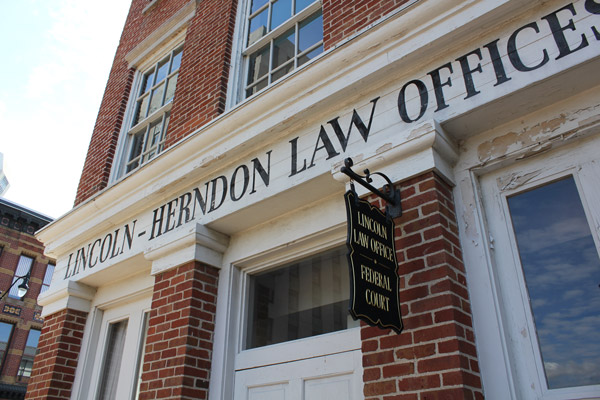
A very well hung shingle.
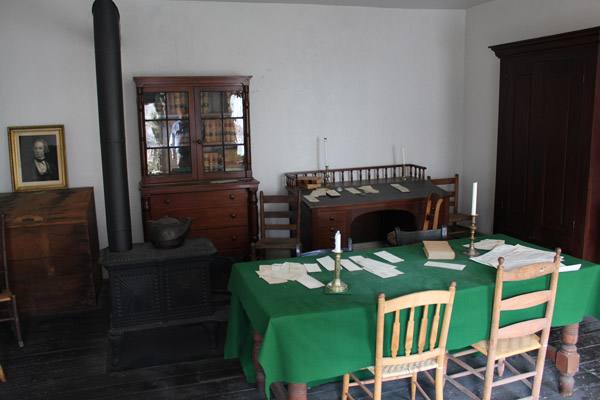
Historians' best guess at the organized chaos of Lincoln's law office.
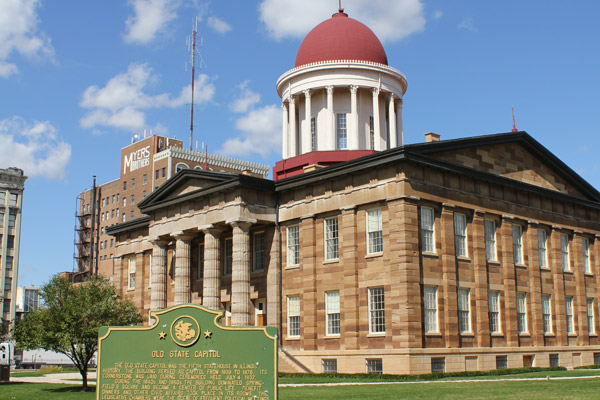
The still new-looking Old State Capitol.
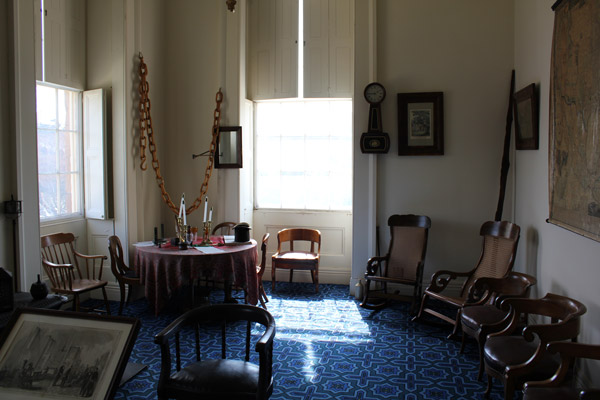
Offices in the Old State Capitol.
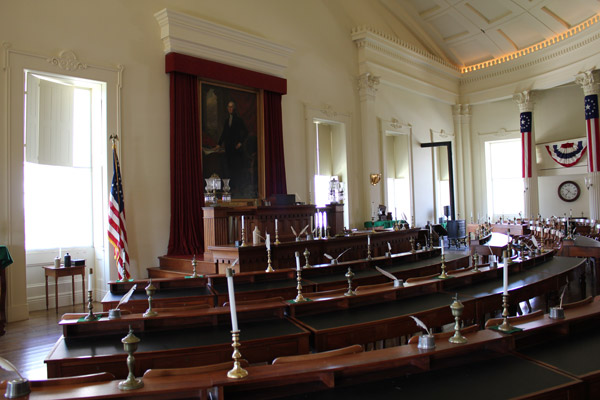
A re-creation of Abe's old stomping grounds at the Old State Capitol.
Some say Abe Lincoln was a bone golem, animated in 1860 by the Illuminati in a sinister attempt to maintain their dominance of the military-industrial complex. Experts such as myself know he was a lawyer. It's a subtle difference, but a difference nonetheless.
Abe had four different offices during his years in Springfield. Three of those buildings are gone, but the one remaining structure is now (surprise!) a museum. There's not a ton of original Lincoln swag left in the building, but they do a nice job of laying out his legal career:
It's the 1830s. Twentysomething Lincoln has been toiling his whole life, and is probably a little sick of professions that involve regular exposure to animal waste products. After a stint in the state legislature, he starts to feel a little self-conscious about his lack of legal knowledge. A voracious reader, he consumes enough information over the next three years to be considered a lawyer by Illinois standards.
Abe lands a job in Springfield, and moves into that prairie town as a junior partner. He works on every kind of case, from civil litigation to capital punishment cases. The state code could be printed on a place mat back then, so you didn't need to be a specialist. He goes through a couple of partners before settling down with William Herndon, who will be his partner through his death (and afterward, his biographer).
Lincoln goes for the big bucks by "riding the circuit" -- since there was one federal judge for all of Illinois, that judge had to travel from county to county on the back of a burro, dispensing justice and leaving a trail of judicious babies. The lawyers traveled as well, so Lincoln was away from home for two to three months at a time. This is beneficial financially. It is very beneficial politically -- it gives Lincoln a chance to meet power players throughout Illinois. It is extremely beneficial in the marital sense, because three months away from Mary is a good thing.
And it turns out that Lincoln is a decent lawyer. Herndon was the paperwork guy, and Lincoln was the talker. He knew how to work a jury, and he also scored lucrative gigs working for the railroads.
The law office, like everything else in frontier Illinois, doesn't reflect the level of success. It was above a dry goods store, which was next to a farmer's market -- as the guide put it, the 19th-century equivalent of a Super Walmart. You could walk up without an appointment, and Lincoln would hear you out while stretching out on couch. The place was probably a mess. Lincoln was a bit of a slob, and some days his young sons would be jumping on the desk. Professional stuff.
There's something to be said for the location. The feds rented space for the circuit court right next door. And the law library for the state (four books and a pamphlet, in the 1840s) was housed across the street in the delightful Old State Capitol building. These days, the exterior of the building is close to original, but the interior is a re-creation -- the original insides smelled too much like frontier justice and had to be replaced. Lincoln served here during his last term in the state legislature. He ran his 1860 presidential campaign out of the governor's office (the governor had died, so it was totally cool). He gave the "house divided" speech in this building.
When Lincoln left Springfield for Washington, he told Herndon to keep his name on the law office sign, so that he could rejoin his partner when he was done leading the country.The closest he got to returning to the office was the Old Capitol, where his corpse laid in state.
The Old Capitol is now just a historic site, since the state moved operations to a fine structure just a few blocks away. That's also a historically significant building, in that many a fine corrupt Illinois governor kept offices here. Rod Blagojevich? You know it. George Ryan? Of course! The Illinois legislature meets there, and the Senate chamber is sort of intriguing. Another Illinois lawyer with no executive experience once served in that chamber, and like Lincoln, he went on to be president. Guess which one. Go on, guess.
President Lincoln's Cottage, Washington, DC
Visited in 2009, 2014, 2016, 2017 and 2018.
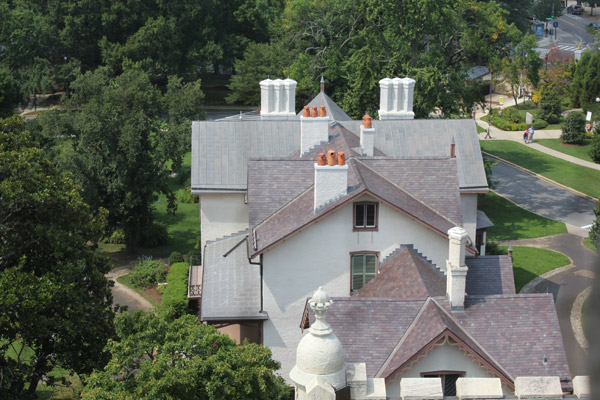
The cottage from above (shot from the tower of the nearby Sherman building).
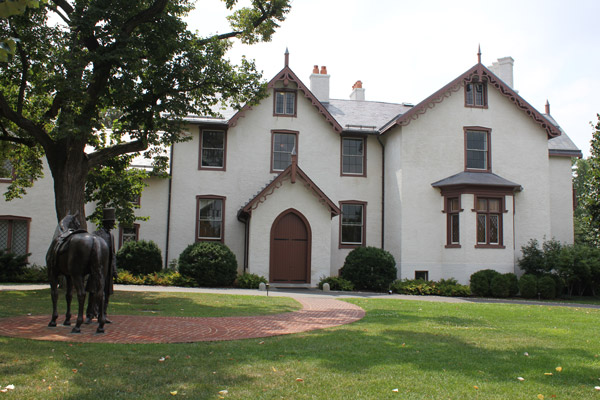
The Anderson Cottage, Lincoln's favorite retreat.
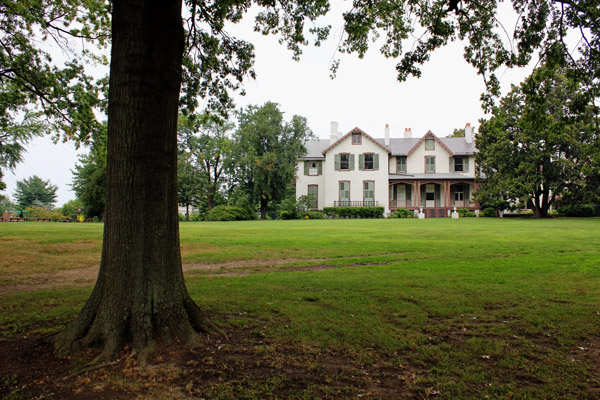
The cottage, from across the lawn.
In the days before Air Force One, or Cadillac One, or anything much above Ornery Mule Train One, presidents relied on staycations for relaxation. Lincoln, for example, would get away from the horrors of war by heading three miles north of the White House. To stay with a bunch of soldiers. Next door to a cemetery where more soldiers killed under his command were buried every day.
But hey, there were some nice breezes there!
The inaccurately named Lincoln Cottage (it was also a retreat for James Buchanan, Rutherford Hayes and Chester Arthur) was Abe's home away from his home away from home. He stayed there for about a quarter of presidency. Since downtown Washington was a) a military parade ground and b) a malarial swamp, it was nice to escape the White House.
The location of the Soldiers Home was ideal. It was established in the 1850s as a refuge for retired and disabled soldiers. The campus was rural (the city had not yet grown that far north), it was cooler than the humid lowlands along the Potomac, and it was still a manageable 40-minute horse ride from the White House. It also boasted a very nice cottage -- originally built by a prominent Washington businessman -- that could accommodate the president and his entire family. Military leaders extended an open invitation to the president, and Lincoln didn't look a gift horse in the mouth. When summer rolled around, he packed up one wagon of flatware and 12 wagons of Mary Todd's various medications and headed to his personal Shangri La. Lincoln also visited the grounds whenever he needed to clear his head.
The facility was exceedingly quaint, except for the 50 funerals a day visible from the front porch. After extensive renovation, the house opened to the public in 2008. The exterior is in fantastic shape, while the interior is used as a "museum of ideas." The place is mostly furniture-free -- you don't get too much of a feel for what it looked like as a functional home. Instead, the very well-produced tour focuses on the Emancipation Proclamation. Lincoln did some of his most involved thinking on the subject while kickin' it at the cottage. There's also some nice attention to Lincoln's relationships with the soldiers all around him at the home, as he had a genuine affection for the troops and was constantly reminded of their sacrifice by the constant funerals on the grounds. There's a nice little museum to get you amped before the tour.
Casual history fans might be underwhelmed, but it's a brilliant spin on presenting a historic home -- the curators also use the structure as an event space for everything from speeches to cocktail parties to comedy shows. (Full disclosure, I help produce the comedy shows, and they're great. Just sayin'.)
FUN LINCOLN COTTAGE FACTS!
- Lincoln rode to work on horseback when staying at the cottage, and during one of his commutes an attacker put a bullet hole through his hat. Historians are divided on whether this was an assassination attempt or an early documented case of Washington-area road rage.
- Young Tad Lincoln was a mascot of sorts for the soldiers on the grounds; they dubbed him a "3rd lieutenant," and willingly served as infantry in Tad's eight-month seige of his governess' boyfriend's home.
- The months when Mary would visit family in the north, Lincoln would stay in the cottage alone. He called these "the most pantsless times of my life."
- Hidden somewhere under the floorboards of the cottage is a secret draft of the Emancipation Proclamation in which Lincoln emancipates the nation's minds, in the fervent hope that their asses might follow.
- By freeing him from the social functions and favor-seeking guests of the White House, the cottage let Lincoln relax and enjoy his true passion: looking tired.
- Frank Lloyd Wright's son invented Lincoln Logs, so don't feel bad about how much you disappoint your dad.
Gettysburg National Cemetery, Pennsylvania
Visited in 2008.
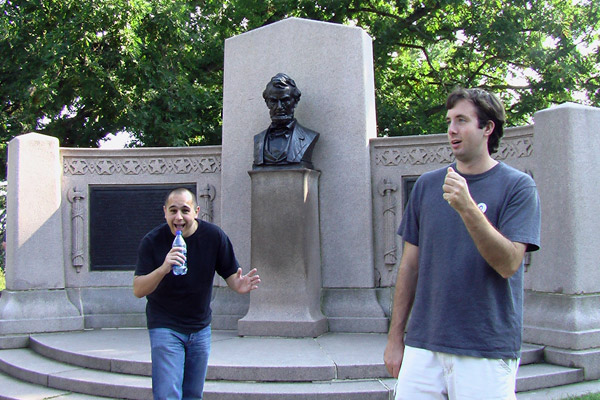
The Lincoln Monument, not far from the spot where the speech was delivered.
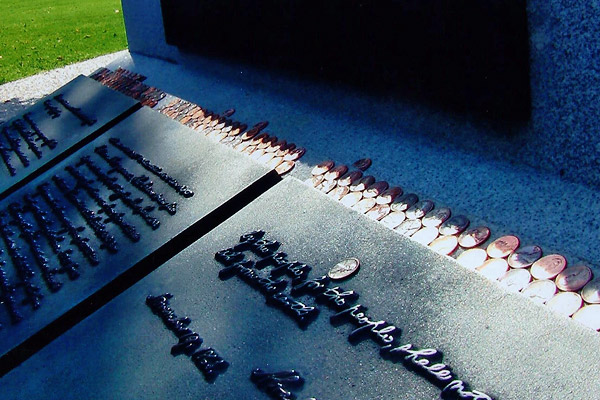
Lincoln gave us his two cents, and now we repay him.
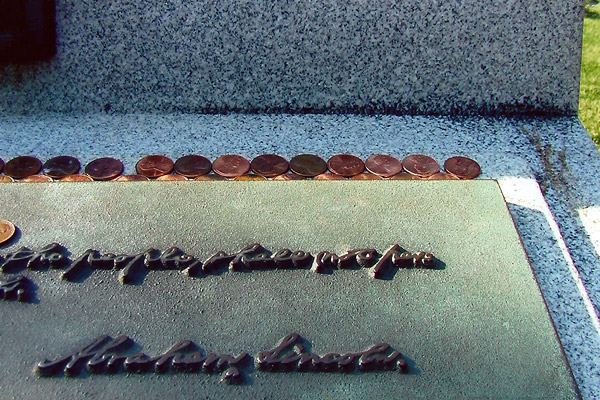
Pennies for some thoughts.
Once his presidency started, Abraham Lincoln didn't get to leave Washington much. Going back to Illnois was out of the question and the Wright Brothers were still several decades away from inventing a convenient way to get to Martha's Vineyard. Besides, with a war on, vacation was out of the question. When Lincoln did get to leave town, it had to be for work. The presidential thing was to survey some defenses, or talk to troops, or strategize with generals at some camp.
Or dedicate a cemetery. The battle of Gettysburg, one of the most brutal and deadly engagements of the Civil War, took place in July 1863. There were a lot of dead bodies, and the expedient thing to do in these situations is dump them in shallow graves. You can have corpses lying around; it hurts property values. But a few months later, weather had started to expose some of the rotting dead. There were very real concerns about disease (and property values), so the community demanded a proper cemetery.
That cemetery was ready for burials by the middle of the fall, and a few weeks after that process started, they had a dedication ceremony on November 19. The guest of honor was actually some guy from Massachusetts that you never heard of. He spoke for two hours, because that's how long speeches were allowed to last in the age before radio and television. After that, it was time for a few words by the president, who had arrived by train the night before.
The speech now known as the Gettysburg Address now seems like the ultimate mic drop. There are a few versions of the text, but the general consensus is that it lasted 10 sentences and 271 words. Every American knows its opening words ("Four score and seven years ago") and some older people know the whole thing by heart, as public schools used to force you to memorize stuff like that. Plaques containing the full text of the speech can be found at veterans cemeteries across the country. It might be the most famous speech in American history; it's certainly up there with JFK's inaugural address and MLK Jr.'s "I Have a Dream" speech.
It is therefore your patriotic duty to visit the spot where the speech was delivered. There's is a ridiculous amount of stuff to see in Gettysburg, for any history-loving American. The battlefield tour alone could fill your entire day, plus you can visit Dwight Eisenhower's farm and some nearby outlet malls. But the cemetery is in the thick of it all, and it only takes a few minutes to check out the impressive Soldiers' National Monument (finished in 1869). The government believes that the monument is roughly where the dais was located in November 1863.
And just for kicks, they installed another monument to Lincoln's speech. It's much tinier, but it has nice look to it, and on the back side they have the text of the address. Visitors decorate it with pennies, head side up.
Ford's Theater, Surratt Boarding House and Petersen House, Washington, DC
Visited in 2019 and a bunch of other times.
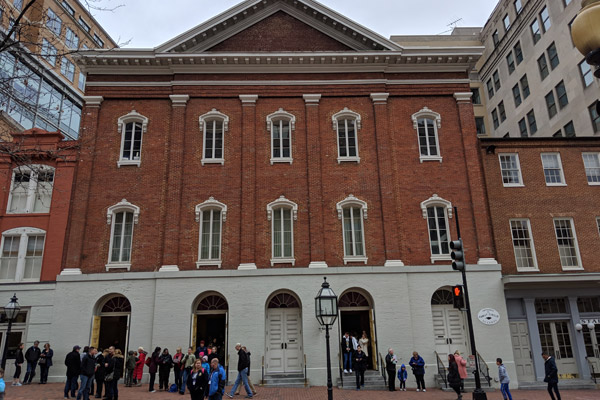
Ford's Theater: The location of Lincoln's Curtain Call, on 10th St. NW.
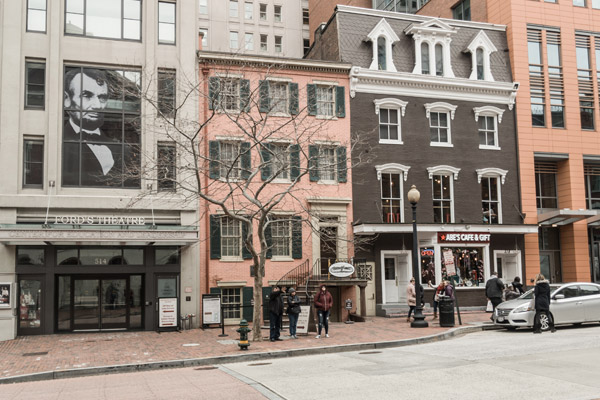
The salmon house is where Lincoln Died; to the left is the "aftermath" museum.
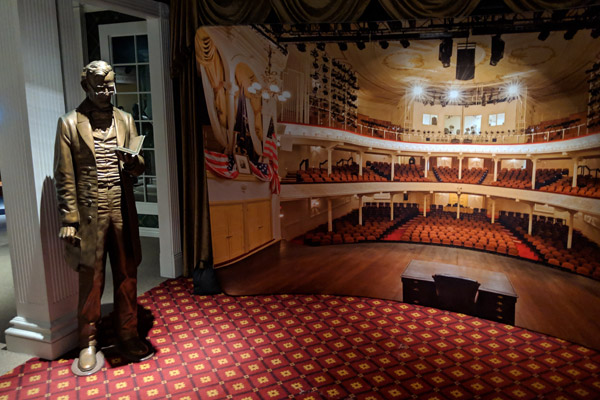
Inside the museum under Ford's Theater.
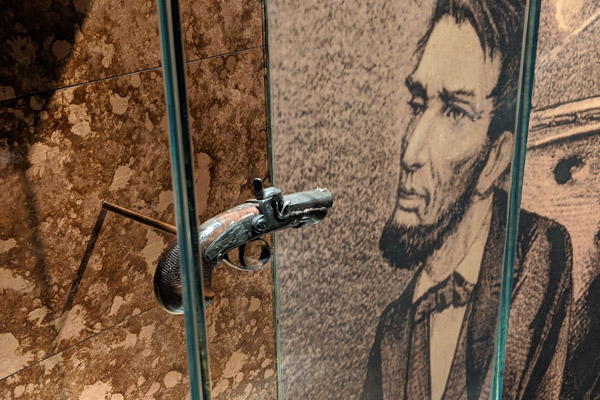
Guns don't kill people. John Wilkes Booth kills people.
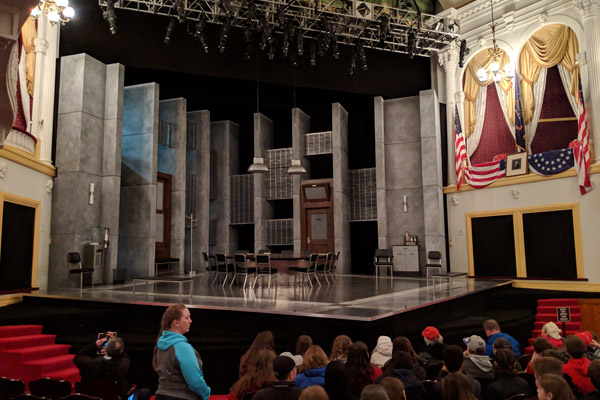
The reconstructed theater, set for a production of "12 Angry Men" in 2019.
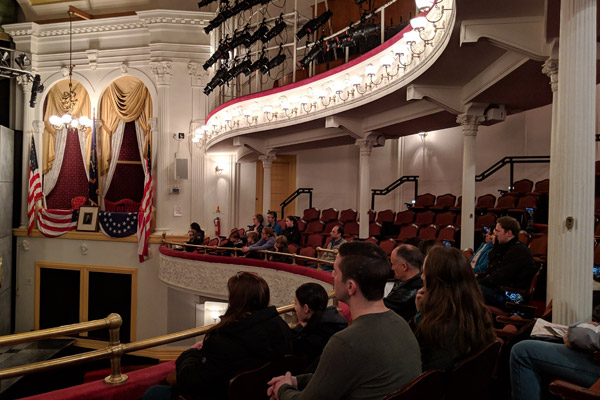
On the balcony, looking at the president's box. Booth entered through the yellow door.
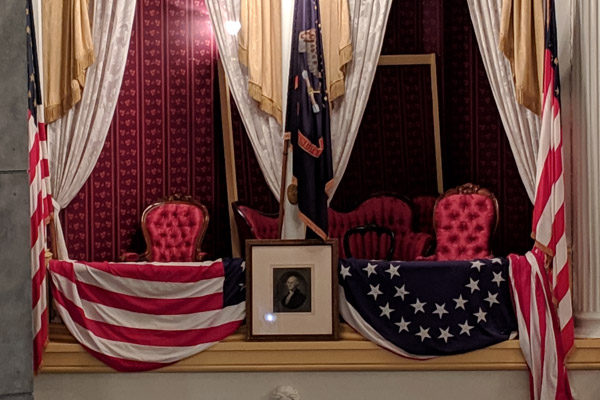
Lincoln's spot was in the left opening. His guests were on the right.
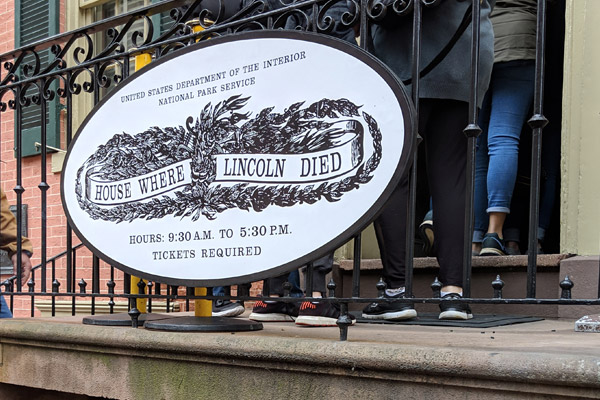
The sign is new, but the design is old. Cool.
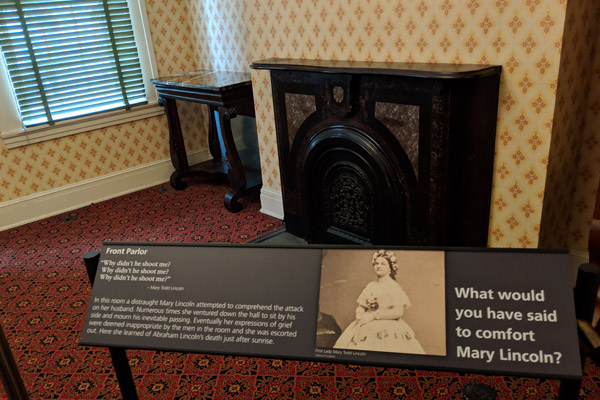
The front parlor of the Petersen House, where Mary Todd waited.
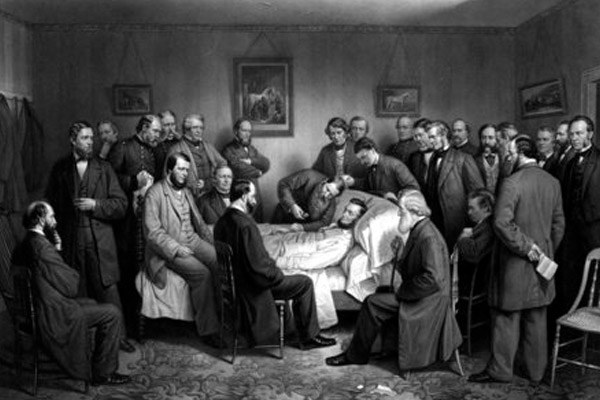
The famous (and fictional) print of Lincoln's deathbed ...
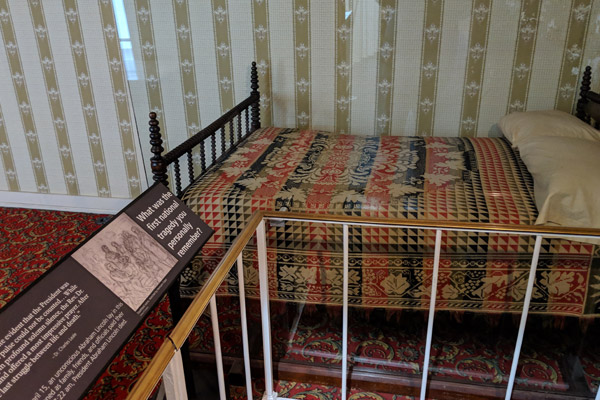
... versus the actual room. Taken from the doorway, which is maybe 4 feet from the bed.

The tower of books! No one reads anymore, but it's still a cool visualization.
Abe Lincoln gave millions of Americans a great reason to avoid live theater. It was his parting, and perhaps greatest, gift to the nation.
Of course, anyone afflicted with the presidential history bug will still feel compelled to see Ford's Theatre. All of Washington was in a festive mood on April 14, 1865. The main Confederate army had surrendered at Appomattox a few days earlier. No one had thought up the 16th Amendment yet, so no one was freaking out about the tax deadline. And even though Loverboy was more than a century away, the entire town had been working for the weekend. April 14 was a Friday, and people were ready to party. Lincoln, who greatly enjoyed the performing arts, decided to take in a production of "Our American Cousin," the smash comedy that was sweeping the nation. And the rest is history.
Washington has changed a great deal since 1865, but Ford's is still located in the bustling heart of downtown Washington -- just blocks away from a period-appropriate Hard Rock Cafe. That said, Ford's has changed a good bit as well. The business was ruined after the assassination, as nice people were turned off by seeing theater at a crime scene, and creepy Confederate sympathizers were making pilgrimages to the site. The federal government bought the builidng, gutted it and converted it into office space. This seemed like a pretty good way to deal with the problem, until three of the upper floors collapsed in 1893, killing 22 people and injuring scores more. The property kept languishing, and the surrounding neighborhood wasn't so great, what with the crack epidemic and so forth.
Historic preservation do-gooders saved the day in the 1960s, rescuing the building from demolition and steering it into the hands of the National Park Service. They refurbished the theater to its appearance the night Lincoln died, while installing all the fancy flush toilets and other amenities that modern theatergoers have come to expect. Ford's is a theater again, which also features a nice little museum in the basement about Lincoln's last night on the town and the people who ruined it. (Highlight: The actual pistol that Booth used to kill Lincoln. For info on the bullet, read the entry on the museum in Silver Spring.)
When I visited in 2009, I watched actors recreated the Lincoln-McClellan relationship through the art of dramatic reading. (It turns out McClellan was a jerk.) Then, the historian who wrote the presentation gave long-winded answers to questions by people who have built elaborate fantasy scenarios that start with them asking a question at a presentation, then end with the historian as part of their wedding party. It was like experiencing the magic of "Book TV" on C-SPAN 2, without being able to change the channel!
I enjoyed it thoroughly, and it gave me a chance to gaze upon the reproduction of the famous box where Lincoln sat. It's one thing to know that John Wilkes Booth jumped from the box to the stage; it's another thing to actually see what that drop would have been like. It probably hurt. A lot. Not as much as being shot in the head, but still ...
Ford's also stages excellent productions OUTSIDE the theater. If you're a truly adventurous tourist -- and you have 38 friends with you to help split the $680 flat fee -- then you should definitely enjoy history in its purest form: A walking tour with a guide in period costume. Yes, an actor portraying a 19th century police detective will guide you through the plot to murder the president. And it was a dastardly plot indeed. Long before Fidel Castro and the Freemasons joined forces to assassinate President Kennedy, or railroad executives and the Freemasons joined forces to off McKinley, or Lucretia Garfield, her lover, Chester A. Arthur and the Freemasons took down Garfield, there was a conspiracy most foul to take out Lincoln!
Sincerely, it was a fantastic tour (at least when I took it in 2009). The actor walked us around the neighborhood as he tried to piece together how Booth escaped, who had helped him and whether the whole dirty business was linked to a simultaneous attack on the secretary of State. They didn't have luminol back then, so investigating mostly involved talking to people and hanging around horse stables. And yet, that was all they needed to determine that there was a conspiracy, and that it consisted of the 1865 equivalent of Brad Pitt and a bunch of drunk wackadoos.
The overall plan was to simultaneously kill a bunch of high-ranking officials in an unprecedented act of terrorism, thereby spreading panic and possibly relaunching the recently ended Civil War. Lincoln got capped; Secretary of State Seward was sliced up pretty badly by a potential assassin, and Seward's son's head was bashed in. An attempt on Vice President Andrew Johnson failed when his assigned attacker lost his nerve and fled, though Johnson had security-free quarters in a Washington hotel. In fact, almost everyone had laughable security back then; Booth got access to Lincoln more or less by asking for it (he was a famous actor). Seward's attacker just pretended to have a package of medicine to help the secretary get over the flu. Contrast that with the seven cavity searches you must now undergo to by a magnet at the White House gift shop. It was a simpler time!
Booth managed his initial escape, but he left a trail a mile wide. That more or less hung his comrades out to dry, by giving the police so much to work with. The tour takes you through a bit of downtown DC, past where Booth's hotel would have been, past were other conspirators would have been boarding, past the telegraph office ... every place that would have figured prominently in the investigation and Booth's escape. Our guide (Kip) was well informed and engaging. Plus he recognized me as a comedian, which automatically increased my estimation tenfold.
If you're visiting Ford's Theatre, then it's only natural to see the location where the final curtain fell. The creatively named "House Where Lincoln Died" is right across the street from Ford's, next door to the Lincoln Souvenir Outlet. You can't miss it. You won't see much on your visit-- the structure is original, but all the furnishings are period pieces or replicas. After the death of Lincoln, a cloud hung over the building. It was a boarding house at the time, and people kept on staying there, even in the Lincoln death suite. The owner, William Petersen, felt a profound sadness about the place; to the end of his days he felt nothing but grief had come to him over the whole incident. Plus people were constantly barging in and stealing "souvenirs." So when he finally shut his business down, he sold off everything in the building to wash his hands of the affair. The actual deathbed is in Chicago, but most of the furniture is lost to history. They have one blood-stained pillow left, and it's on display in the museum underneath Ford's theater.
Thanks to the magic of lithography and a few eye-witness accounts, they do have a pretty good re-creation of what the room looked like on April 14. Lincoln was carried in from across the street at the urging of a boarder who heard the commotion outside. They carried Lincoln to the back of the first floor, into the room of Thomas Proctor, a 17-year-old clerk at the War Department who was out for the evening. It's a tiny, tiny room. Lincoln probably didn't fit on the bed, and with a Who's Who of Washington flitting in and out all night, it's easy to imagine how cramped it must have been.
When Abe kicked it on the morning of April 15, Secretary of War Edwin Stanton supposedly said, "He belongs to the ages now." Though some insist he said, "He belongs to the angels now." And still others believe that he said, "I guess I should update my resume, just in case."
In recent years, they've tacked on an "Aftermath" museum, in a modern building connected to the Petersen house. It tells you a little about Lincoln's funeral, the manhunt for Booth and the trial that led to death sentences for a bunch of the conspirators. Then you exit through a few rooms touting Lincoln's legacy, and past the "tower of books" -- allegedly, Lincoln is the most written-about person in American history, and they're illustrating the point with a symbolic stack of tomes that's a few stories high. On closer inspection, some of the books in the stack are fake, and the interior is probably hollow, but that's probably better than building a giant book-mite nest out of tell-all Lincoln biographies from the 1870s.
All this learning will probably make you hungry. The are many fine options around Ford's Theater, such as the Hard Rock Cafe where Lincoln met the lead singer from Nickelback, and the Dunkin' Donuts where Edwin Stanton got his coffee every day. But the best option is Wok n' Roll on H Street -- a few blocks from Ford's in DC's tiny Chinatown. Wok n' Roll was once the facility where the Lincoln assassination conspirators met. Back then it was a boarding house owned by Mary Surratt. It was not a sushi bar in the 1860s, sadly. John Wilkes Booth wasn't pounding freshwater eel while thinking about what to yell from the stage. History is awesome, but it can't be totally awesome all the time.
Mary was a pioneering feminist, who greatly advanced her gender's standing by being the first lady ever executed by the federal government. Evidence implicating her as a hardcore conspirator was flimsy, but at the very least she was guilty of bad parenting. Her son John (a Confederate spy) was in on it, although he avoided prosecution for a few years by fleeing the country.
There's a lesson here: If you let your adult children bum around the house, they're just going to drink your liquor, have their deadbeat friends over and eventually kill the president. Tough love is the patriotic thing to do.
But the important thing here is that you have a meal at Wok n' Roll, and read the beat-up historic plaque by the entrance. Also, because it's not clear exactly where the assassination planning happened, you have to cover your bases: Have a drink at the bar, get some sushi in the restaurant, and definitely make use of the private karaoke rooms upstairs. You owe it to Lincoln.
And now, just for kicks ...
On April 22, 1865, Thomas Proctor attempts to get his cleaning deposit back
Mr. Petersen! About the bill -- I wanted to ask about this small matter, down at the bottom ... Yes, the room was less clean than when first I rented it. But I am not at all responsible. Who? I think we both know the answer to that, Mr. Petersen.
Mr. Petersen, remarks on the quality of my parentage are uncalled for! Stop crying Mr. Petersen. Stop! Yes, we all miss him. Maybe me a little less than most, since I have been picking pieces of his dura mater off my headboard for the last week.
Not again with the crying, Mr. Petersen! Now, can we go point by point?
First off, the scuff marks were hardly my fault. I had to have the cot dragged in, Mr. Petersen. I had an early appointment and I needed my rest. Not that it mattered, because Mrs. Lincoln snores like a drowning buffalo. I almost invoked your own no pets policy. And might I add, she stole my copy of Harper's and didn't once offer to chip in her share of the boarding fees. But I'm letting that slide, Mr. Petersen, for the good of the nation.
Second, the smell. Mr. Petersen, have YOU ever tried to ask the Secretary of War to stop smoking? Oh, wait, of course you haven't, because you were there and you DID NOT. I know he had reason to be stressed! I'm not saying he isn't a great man, Mr. Petersen! I'm just saying he was smoking. Like a chimney. Very close to the drapes. Well of course I was moved by his words! I didn't get to hear exactly what he said when the President passed away, as I was trying to catch up on some paperwork for my morning appointment while laying on a pile of dirty rags behind the building. But the rats in the rag pile seemed deeply touched.
Which, by the way, there's a rather large and rat-infested pile of dirty rags behind the building. I'm just saying is all.
As to the chunks missing from the furniture, the tears in the wallpaper and stains in the rugs, I think the 2,536 people who took advantage of your "open door" policy last week might have something to do with that. It's not national mourning when they're going through my drawers, Mr. Petersen. Somber people don't carry hand axes and try on my pants for fit. They just don't.
Now, the water rings on the nightstand . . . well, that's probably on me.
But I certainly am not paying for the blood stains on the baseboard. It was not me, sir! Do you see any gaping head wounds, Mr. Petersen? Accuse me again and you might!
YOU can't believe this? I step out for the evening to enjoy a meat pie, and when I come back, with a fine young lady on my arm I might add, half my shirts have been commandeered as blood mops and the leader of the Union is drooling on my embroidered pillow case. Do you know how much that kills the mood, Mr. Petersen?
Not that you'd ever be in the mood judging from the looks of Mrs. Petersen. And just try finding a drycleaner who won't break down sobbing when you try to bring those shirts in.
If you think you're getting this $2.50, you're sorely deluded, good sir! Sic semper tyrannus!
OK, that was too soon. You can cry on that one, Mr. Petersen.
The Dr. Mudd House Museum, Waldorf, Maryland
Visited in 2014.
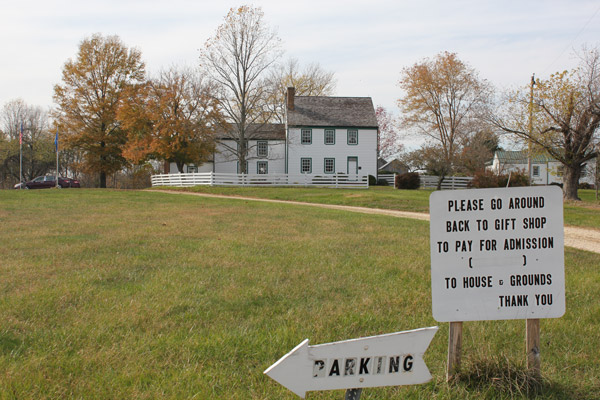
This way to the good, conspiratorial times!
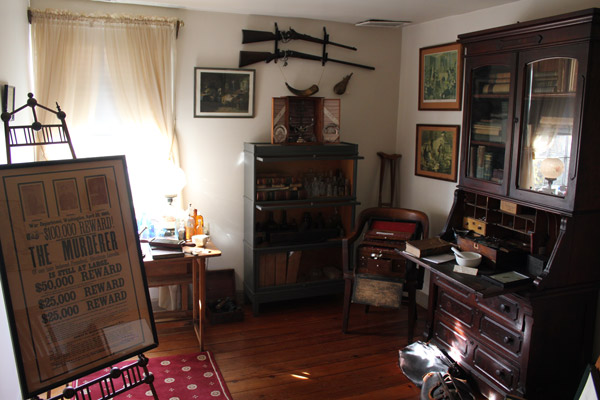
Mudd's office: The doctor isn't in.
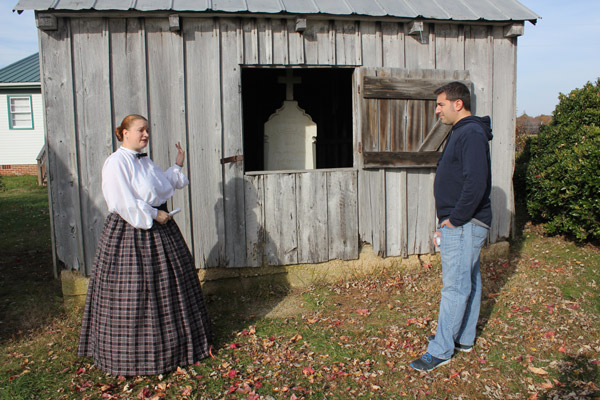
Talk to your docents. They're good people.
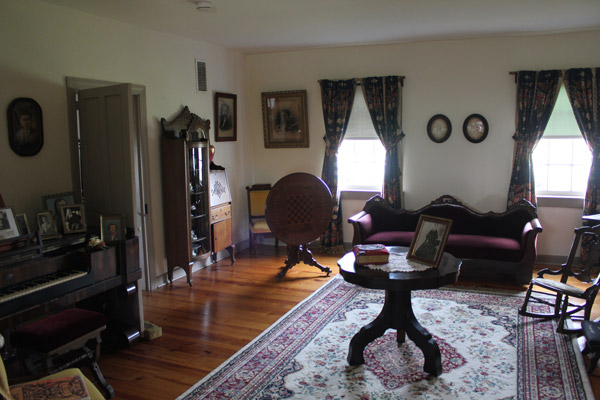
The fateful couch where Booth crashed.
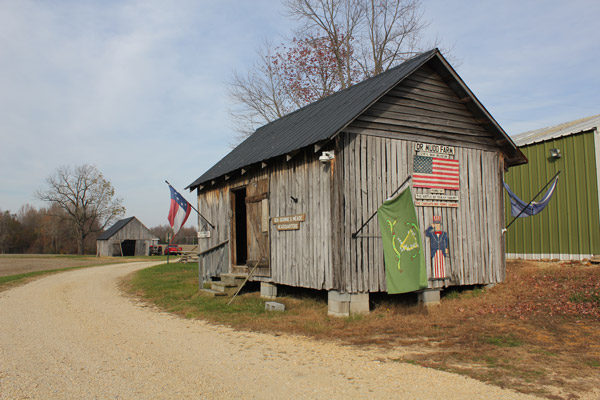
Mudd's sugar shack? I can't remember, honestly.
It's flattering if museums celebrate your life. But when you're really special, museums celebrate the people who murdered you. In the Washington area, tourists can visit Ford's Theater and the house where Abraham Lincoln died -- but there's so much more! You can make a weekend of it! This is exactly the kind of trip that might save your marriage!!! All you need is a car, $7 for an admission fee, and the willingness to go to Maryland.
Maryland bills itself as "The Free State," a nickname that originates from some 19th-century rebranding. Before 1864, it was slave country, filled with plantations, horrific racism and all the other romantic vestiges of the Old South. Some people insist that it stayed in the Union thanks to the undying patriotism of many fine citizens, but in many cases, it was the special kind of patriotism that only comes from having a gun pointed at your head. There were Union troops present all the time.
There wasn't much of a "hearts and minds" campaign going on, so lots of Marylanders spent the entire war hating Abraham Lincoln -- Samuel Mudd among them. Mudd grew up on a big tobacco plantation in Charles County, southeast of the Capitol. His family had dozens of slaves, and much like your father got you a used car, Samuel eventually got his own 200-acre farm and a few slaves of his own. But he was a double threat! Mudd also studied to be a doctor.
Late in 1864, the war wasn't going so good for the South; the only real hope was the Civil War equivalent of blowing up the Death Star. A group of conspirators made plans to kidnap Lincoln, and then maybe exchange him for Confederate POWs. John Wilkes Booth traveled through Charles County to scout out an escape route, and on that trip he met and stayed with Dr. Mudd. At that point, Mudd was probably included in the conspiracy. He had drinks with other conspirators during a trip to D.C., a few days before Christmas.
Eventually, the plan changed from kidnap to murder. Whether Mudd knew about the change is open to debate -- but when Booth was fleeing Washington with a broken leg (injured when jumping onto the stage at Ford's Theater), he made his way to Mudd's farm. He knocked on the door at 4 a.m. Mudd took Booth upstairs, cut off his boot and set his leg. Booth, a famous actor, also shaved some of his facial hair. At some point in the next day, he was on the run (or limp) again.
Mudd reported Booth's visit to the authorities a few days later, because that's what you do when you're trying to look innocent. He fudged the details of his past dealings with Booth -- for example, he covered up their meeting in December. Once the omissions were discovered, it was suspicious enough that Mudd was arrested. He was spared the noose, but he did get shipped to Fort Jefferson, an island prison in the middle of the Gulf of Mexico.
Then Sam Waterston said something pithy and Dick Wolf's name appeared on a black title card.
All this information is brought to you by the good people of Mudd House in Waldorf. The doctor's home is now a museum, and it's not just a cheap attempt to cash in on Lincoln's fame. The Mudd family kept the property for generations, and they're the ones who converted it into a historic site. One relative spearheaded this effort, allegedly believing that the ghost of Dr. Mudd had told her to do so; in ambiguous ghost fashion, he either feels terrible about what he did or wants his name cleared.
The family scoured the attics of descendants for old relics from Dr. Mudd's time, and they banded together as a unit to purchase other Mudd memorabilia at auction. The home is in great shape -- it has a live-in caretaker -- and most of the decor is original. The living room has the couch that Booth laid on when he first arrived. There are pieces of furniture made by Mudd himself, some dating from his time a prisoner. His office is filled with old-timey-medical-looking thingies. And you can stand in the bedroom where Booth's leg was set. The Mudd family held onto the Booth's boot for a long time, and right now it's on extended loan to Ford's Theater.
Most important, the tour was excellent. Superfriends Andrea and Jared invited me along on a Sunday afternoon, and the three of us got our own docent. The tour only covers about five rooms, but we got an hour of really interesting conversation out of the deal. Mudd's story didn't end with prison. He tried to escape once, but he eventually made himself into a model prisoner. Yellow fever killed the prison's doctor, and Mudd stepped in to take care of everyone else. He was pardoned by Andrew Johnson before serving four years, and he got to return home.
According to our docent, it was like he never left. Sure, there's always that awkward transition period where your neighbors dance around the fact that you might have helped murder the president. Maybe there are a few lame excuses as people duck out of your birthday party. But eventually, your neighbors remember that they're all still racists and that they're OK with what you did. Mudd lived to the age of 49 before dying of illness; he fathered four or five more children after getting out of the joint.
He also had an unusual houseguest. Edman Spangler was a stagehand and Ford's Theater; he knew Booth and arranged for someone to hold Booth's getaway horse on the night of the assassination. He also got shipped to Fort Jefferson, and he also got pardoned by Andrew Johnson. Society was less kind to Spangler, so the Mudds gave him five acres to farm and let him live over their garage (or the 19th-century equivalent thereof). It was like "The Shawshank Redemption," only both guys were probably guilty, neither guy was black and there wasn't a beach.
Oak Ridge Cemetery, Springfield, Illinois
Visited in 2011.
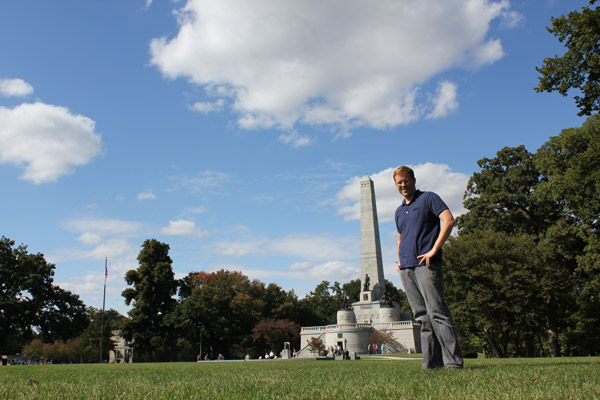
Abe's final resting place.
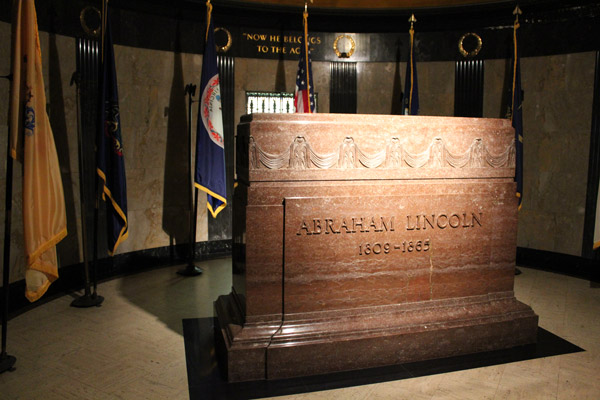
The very fine Arkansas granite marker inside the tomb.
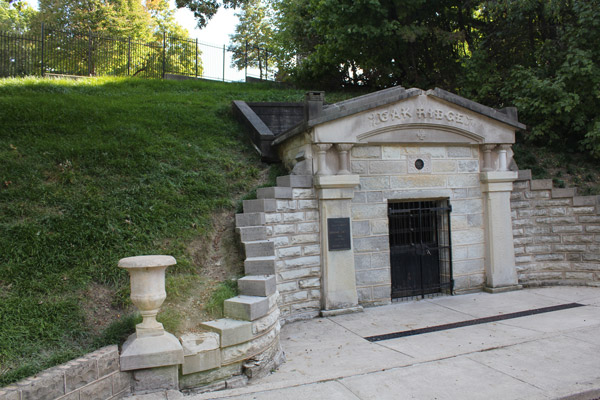
The original (temporary) burial vault.
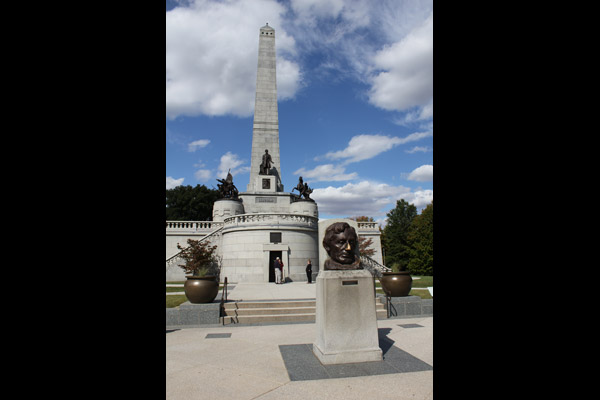
A wide vertical shot of the tomb's exterior.
Abraham Lincoln's death was a wee bit unexpected, but the country did manage to throw together a U.S. funeral tour in short order: Abe's corpse traveled 1,700 miles by train back to Springfield, with stops for funeral services and body-viewings along the way. Unfortunately, that took only three weeks of time. So when they got to Oak Ridge Cemetery -- in Lincoln's adopted hometown of Springfield -- the remains were deposited in a stopgap resting hole.
Oak Ridge's "public vault" was the first semi-official resting place for Lincoln's bones. The number of visitors to the public vault was stunning, so after a few months the remains were removed to a temporary tomb in the side of nearby hill. They rested there for a few years, but the number of visitors was still stunning. So once construction on a proper resting place was partially complete, Lincoln was moved yet again. Once completed, it became the Lincoln tomb that we all know and love today.
It's actually less grand than Grant's Tomb, Garfield's Tomb or McKinley's Tomb, but it is 117 feet of somber awesomeness. It has a distressingly phallic obelisk -- which is always a winning strategy -- a statue of Abe, and four surrounding statues to represent the four services he commanded in the war (army, navy, artillery, cavalry). The Lincoln statue is holding a copy of the Emancipation Proclamation, and a plaque bearing the Gettysburg Address is hanging over the entrance to the base.
As for what's in the base? Until 1931, all you could do was walk in, see a tiny rotunda with a small exhibit on Abe and leave. Today, you get a more personal experience. A marble hallway hallway winds you past a few Lincoln statues. It's dim and sterile, and the drab color scheme has the feel of a 1950s federal building. But suddenly, you're face to face with the big guy.
Actually, "face to face" isn't accurate. Lincoln is 10 feet below a slab of Arkansas granite. There is a fun historical reason for this. In 1876, grave robbers attempted to take Lincoln's remains and hold them ransom. So when the whole burial site was renovated around 1900, Robert Lincoln (Abe's famous son) insisted on making the remains untouchable. Lincoln was put in a metal cage, which was then encased in concrete and sunk well below the surface. Mary Todd Lincoln is in the wall behind him, as are sons Eddie, Tad and William. Only Robert is missing from the family reunion; he's in Arlington National Cemetery.
I lucked out and squeezed into the room ahead of a tour bus with about 68 senior citizens, so I was relatively close to alone. What's striking is the simplicity of the marker; once you're in the burial chamber, it's easy to block out the monument around you and just focus on Abe. The slab dominates the room. It sounds corny, but you can feel its gravity. Lincoln came from nothing, but he somehow managed to cut through the knots that had bound the country since its founding. He was handed an impossible situation and handed back a country finally ready to ascend to greatness.
There's so much fuss over Lincoln that it's easy for a natural cynic to dismiss him. That's harder to do when you've seen his grave.
National Museum of Health and Medicine, Silver Spring, Maryland
Visited in 2012.
I sometimes miss the elegance of the 19th century: rail travel, Victorian manners, and the social acceptability of putting splintered and diseased body parts in a public museum.
A few years ago, I had the great pleasure of stopping by Philadelphia's Mutter Museum, which is a freak show behind glass. That museum has a slightly more tasteful cousin in the National Museum of Health and Medicine in suburban Washington. It was at the Walter Reed military hospital, until some jerk reporters "investigated" to find out that "wounded soldiers were being horribly treated" and they had to close the whole place down. Jerk reporters. A few years later, they finally unpacked what had to be the creepiest storage locker in the world, and the museum has been reborn in Silver Spring, Maryland. I enjoy creepy things, so me, the wife and some friends went to check it out.
It could use more disturbing and haunting deformities, but it's not bad. The real spine of the collection (which includes quite a few spines) is shattered body parts from the Civil War. A guy took a cannon ball to the face, Army doctors couldn't do too much to help him, no one cared about sending his remains back to his dirty rebel family, and presto, you've got yourself a nice centerpiece for the "people shot in the face with cannons" wing. There are cases of broken legs, arms, skulls and ribs, and you get the impression that they've got an Indiana Jones warehouse in the back with a few hundred more crates.
But bones along are boring, so they expanded the collection over the years. That's how it always works: Word gets out that you have a smashed bone collection, then someone on vacation in Thailand sees an elephantitis scrotum in a shop window and thinks of you. You can't turn that down, so now you also collect elephantitis scrotums. Might as well put them in the museum. There's actually a great case of diseased and damaged organs, and the descriptions are off to the side. So you can play a rousing five-minute game of Guess That Disgusting Ailment. There are no winners. Especially not the guy with the elephantitis scrotum.
They also threw in some cool doctor relics, like Civil War medicine bags and saw kits. There's a tiny box with extending electrodes and a hand crank -- it the 1870s version of an electroshock machine. They have the precursor of the artificial kidney, which is the size of very large BBQ grill.
But the highlight for me will always be presidents. A few of the crown jewels from the old Walter Reed Museum are still on display.
First is the bullet that killed Lincoln. If you want to be accurate, it's the bullet that made Lincoln a vegetable -- doctors shoving their fingers in his brain probably killed him. But it's there, and it's shiny and not at all menacing. The bullet is right next to a few chips of Abe's skull, a doctor's cuff soaked with his blood and some of his hair. If an evil genius ever wants Lincoln DNA for the next Serpentor, I know where they're headed.
Far grosser (and cooler!) is James Garfield's vertebrae. Garfield was definitely killed by doctors; they thought the bullet in his body was on the other side from its actual location, and the quack in charge of his medical care didn't really believe in antiseptic medicine. (It was a hot new fad at the time.) He kept shoving dirty things in Garfield's body until the poor guy was basically held together by puss and infections. When they did the autopsy, the doctor for some reason yanked out a couple of Garfield's vertebrae that had been nicked by a bullet, then put them somewhere for safe keeping. Why? Beats me. But now they're in a museum. Next to the Lincoln bullet. Any political opponent who called James Garfield spineless was only partially right, and then only after his death.
I'm willing to bet that they have most of John Wilkes Booth and Charles Guiteau in the storage room (a few pieces of their bones and brains have been on display). New presidents are probably invited over at the start of their term to kick those corpses square in what's left of their junk. It's all strictly confidential, of course, but I'm about 95 percent sure that this happens. Or at least it should.
The museum is small, but it is free, and for that reason I heartily endorse it. You cannot make a museum like this anymore, without people accusing you of kidnapping Chinese peasants and killing them for your anatomy exhibit. The 19th century was so much cooler, except for the slavery and disease.
Fort McNair and Mount Olivet Cemetery, Washington, DC
Visited in 2015.
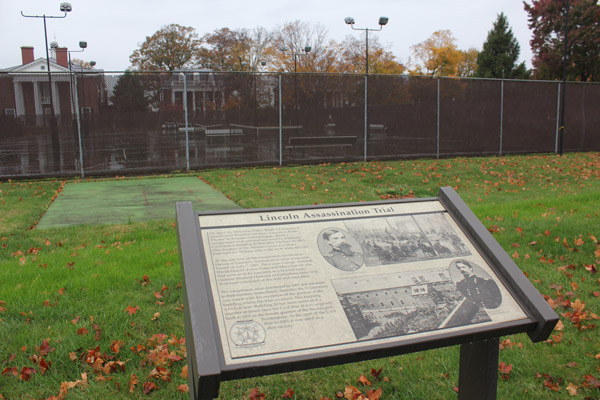
Court is in session. The spot where the Lincoln conspirators were hanged.
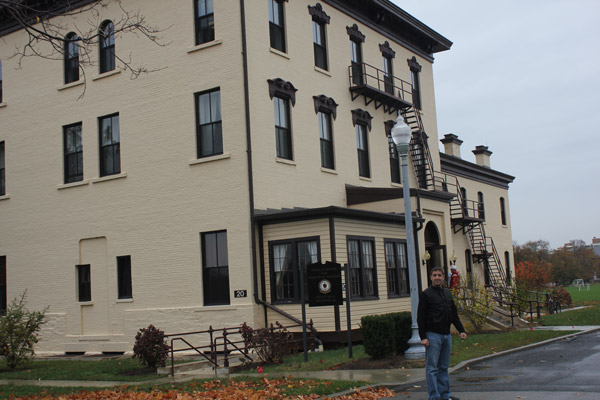
Grant Hall, the building where the conspirators faced a tribunal.
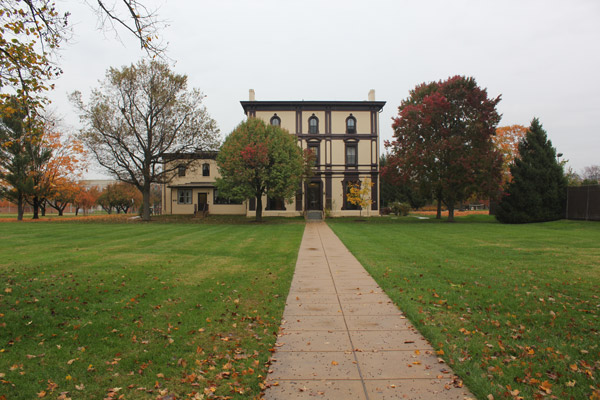
Another view of Grant Hall.
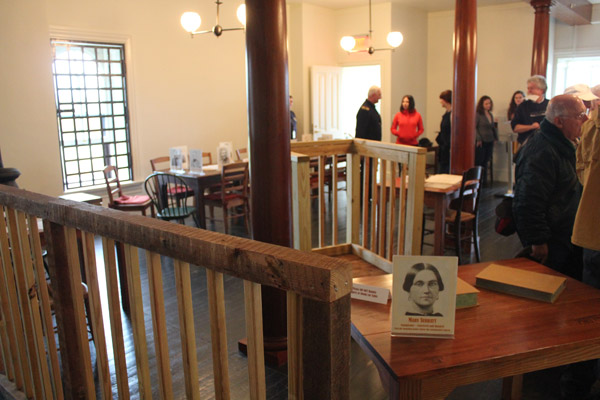
The room where the Lincoln conspirators faced justice.
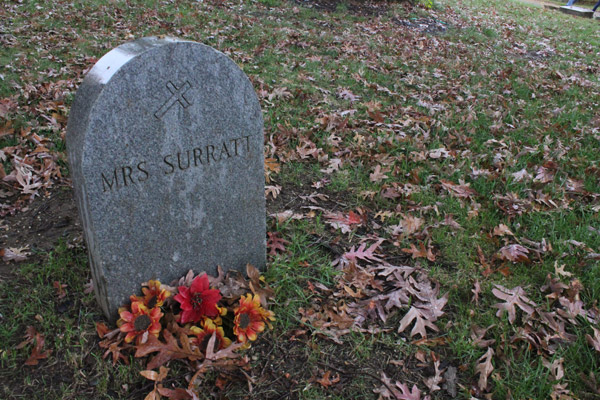
Mary Surratt's final boarding house.
There's an unlimited supply of justice, but these days we're very slow about meting it out. People stay on Death Row for ages, waiting out an endless string of "appeals" and waiting to see if "DNA" might prove that they're "innocent." In the 19th century, everyone was in a hurry, probably because there was a very high probability that you might be felled by an infectious disease at any time. You had to live for the moment, so justice was meted out quickly and emphatically.
Abraham Lincoln died on April 15, 1865. John Wilkes Booth was killed 11 days later, without a trial -- he was shot during his capture. The government also quickly rounded up the people who might have helped Booth. They were held captive at the Old Arsenal Penitentiary in Washington. A military tribunal heard their case in a makeshift courtroom at the arsenal. And on July 7, four of the convicted conspirators were sent to join Lincoln and Booth in the afterlife. It was the social event of the season; you actually had to get tickets to watch them swing from the gallows.
Despite the economic windfalls of execution tourism, the site of the Lincoln trial is usually off-limits to the public. The property has been an Army installation for more than 200 years, and in the late 1940s it officially became known as Fort McNair. It holds the National Defense University -- home of the Fighting Hancocks -- where our military officers learn how to turn rubble into a much finer rubble. Thanks to all those jerks practicing radical Islam, you can't just stroll onto a U.S. military base whenever you feel like it.
But every now and then, they welcome you with open arms! (After checking your car for explosive devices.) In November 2015, me and a few friends checked out an "open house" for the site of the Lincoln tribunal. The building where it took place still stands, and it is now known as Grant Hall. The courtroom occupies the top floor, and it is laid out to re-create the scene of the trial. There was a table for the many military "judges" on the tribunal, a table for the press, a witness stand, and some benches for the alleged conspirators. When the tribunal wasn't in session, the prisoners were held in rooms adjacent to the courtroom. No one wanted the inevitable circus that would result if they had to be "perp walked" into the building each day.
According to the on-site experts (including a few "re-enacters") the days were remarkably long; the previous day's testimony would be reviewed for most of the morning, then new testimony would be heard in the afternoon. The trial took seven weeks, and at its conclusion four of the eight captured conspirators were sentenced to hang. They didn't d*** around back then, so a gallows was constructed right next to the building. One day after sentencing, Mary Surratt, Lewis Powell, George Atzerodt and David Herold were swinging in the breeze. The gallows are long gone, but you can still marvel at the tennis court that sits on the site today. Legend has it that if you make a successful "drop" shot, the ghosts of the prisoners appear and say, "Too soon."
It was a neat little tour. In addition to the courtroom, there are two "museum" rooms on the same floor with artifacts from both the trial and the Lincoln assassination. One of the museum rooms was the holding cell for Surratt, the only female conspirator. She had a nice view of the spot where we she was eventually killed.
And what's more, Surratt is a very curious piece of this puzzle. She owned a boarding house where the conspirators met. Her son was clearly involved in a plot involving the president. Mary definitely knew about some plans to kidnap government officials, but it's not clear if she knew that murder was part of the plan. Most modern scholars who study the transcripts believe the evidence linking Surratt to the murder plot was circumstantial at best.
Even so, she was the distinguished recipient of the first federal death sentence ever handed out to a woman. YOU GO GIRL! Her body was dumped in a shallow grave at the arsenal, but in 1867 President Andrew Johnson decided that the families of the dead conspirators could do what they wanted with the remains. It was his greatest legacy.
Mary was removed to Mount Olivet Cemetery in northeast Washington, where she's resting today. After checking out Fort McNair, we headed to Mount Olivet to see her. Her initial grave marker simply read "Mrs. Surratt." It has since been replaced, but they stuck with a simple marker the same epitaph when they put in a new one. You don't want to seem too flashy when you might have killed the president -- it would be in poor taste. She's under a tree, set off a bit from the other corpses. If you have the chance, you should definitely visit her. And then go visit the restaurant in DC's Chinatown that used to be her boarding house. Sadly, it's not one of those place where the ducks are hanging in the windows.
